Lateral Load Capacity and p-Multiplier of Group Piles with Asymmetrical Pile Cap under Seismic Load
Abstract
:1. Introduction
2. Literature Review
2.1. Piles under Seismic Load
2.2. p-Multiplier
2.3. Soil Stiffness
3. Methodology
3.1. Site Characteristics
3.2. Finite Element Method
3.3. Loads and Material Characteristics
4. Results and Discussion
4.1. Group Pile Lateral Load Capacity
4.2. p-Multiplier
5. Conclusions
- Lateral load capacity of group piles:
- Asymmetrical pile caps and pile configurations do not affect the behavior of lateral resistance and deflection, only producing different lateral resistance values with a difference of 1–50% and 60–70% for deflection values compared to the finite element 3D single pile analysis. On the effect of combination lateral loads, pile stiffness, and soil stiffness, the analysis of lateral resistance and deflection of group piles with 3D finite elements is in good agreement with single pile 3D finite elements.
- In addition, the asymmetrical shape of the pile cap and pile configuration affects the location of the greatest lateral resistance. The slope of the pile cap can increase the shear zone, thus increasing the lateral resistance so that the most remarkable overlap occurs in the direction opposite to the loading direction.
- p-multiplier:
- In this study, the proposed method is less effective with asymmetrical pile configurations, where the value of the p-multiplier increases with an increasing deflection. In future research, it is necessary to not solely divide the lateral resistance of the pile group by a single pile to get the p-multiplier value. In this case, further studies are required to be carried out with the possibility of adding another multiplying or dividing factor.
- Results from Reese and Impe [15] generally match or approach the pm value from the 3D finite element method obtained in this study. This is appropriate because Reese and Impe [15] not only considers the effects of adjacent, parallel piles, but also considers misaligned piles concerning the applied load. The 3D finite element method was within the range suggested by the design recommendations.
Author Contributions
Funding
Institutional Review Board Statement
Informed Consent Statement
Data Availability Statement
Acknowledgments
Conflicts of Interest
References
- National Earthquake Study Library Team. Peta Sumber dan Bahaya Gempa Indonesia Tahun 2017 [Map of Indonesia Earthquake Sources and Hazards in 2017]; Pusat Penelitian dan Pengembangan Perumahan dan Permukiman Badan Penelitian dan Pengembangan Kementrian Pekerjaan Umum dan Perumahan Rakyat: Jakarta, Indonesia, 2017. [Google Scholar]
- Elhakim, A.F.; El Khouly, M.A.A.; Awad, R. Three Dimensional Modeling of Laterally Loaded Pile Groups Resting in Sand. HBRC J. 2016, 12, 78–87. [Google Scholar] [CrossRef]
- Zhou, P.; Zhou, H.; Liu, H.; Li, X.; Ding, X.; Wang, Z. Analysis of lateral response of Existing Single Pile Caused by Penetration of Adjacent Pile in Undrained Clay. Com. Geotech. 2020, 126, 103736. [Google Scholar] [CrossRef]
- Wang, H.; Wang, L.Z.; Hong, Y.; He, B.; Zhu, R.H. Quantifying the Influence of Pile Diameter on the Load Transfer Curves of Laterally Loaded Monopile in Sand. App. Ocean. Res. 2020, 101, 102196. [Google Scholar] [CrossRef]
- Lin, Y.; Lin, C. Scour Effects on Lateral Behavior of Pile Groups in Sands. Ocean. Eng. 2020, 208, 107420. [Google Scholar] [CrossRef]
- Cao, G.; Ding, X.; Yin, Z.; Zhou, H.; Zhou, P. A New Soil Reaction Model for Large-Diameter Monopiles in Clay. Comput. Geotech. 2021, 137, 104311. [Google Scholar] [CrossRef]
- API. Petroleum and Natural Gas. Industries-Specific Requirements for Offshore Structures: Part 4-Geotechnical and Foundation Design Considerations ISO 19901–4:2003; American Petroleum Institute: Washington, DC, USA, 2014. [Google Scholar]
- Zhu, B.; Wen, K.; Kong, D.; Zhu, Z.; Wang, L. A Numerical Study on the Lateral Loading Behaviour of Offshore Tetrapod Piled Jacket Foundations in Clay. App. Ocean. Res. 2018, 75, 165–177. [Google Scholar] [CrossRef]
- Jia, J. Soil Dynamics and Foundation Modeling: Offshore and Earthquake Engineering; Springer: Bergen, Norway, 2018. [Google Scholar]
- Das, B.M. Principles of Foundation Engineering, 7th ed.; Thomson: Toronto, ON, Canada, 2011. [Google Scholar]
- Badan Standardisasi Nasional. Perencanaan Ketahanan Gempa Untuk Gedung dan Non Gedung [SNI 1726:2019] Earthquake Resistance Planning for Buildings and Non-Buildings [SNI 1726:2019]; Badan Standardisasi Nasional: Jakarta, Indonesia, 2019. [Google Scholar]
- Zhou, Y.; Tokimatsu, K. Numerical Evaluation of Pile Group Effect of a Composite Group. Soils Found. 2018, 58, 1059–1067. [Google Scholar] [CrossRef]
- Brown, D.A.; Morrison, C.; Reese, L.C. Lateral Load Behavior of Pile Group in Sand. J. Geotech. Eng. Am. Soc. Civil. Eng. 1988, 114, 1261–1276. [Google Scholar] [CrossRef]
- FEMA P-751. NEHRP Recommended Seismic Provisions: Design Examples; National Institute of Building Sciences: Washington, DC, USA, 2009. [Google Scholar]
- Reese, L.C.; Impe, W.F.V. Single Piles and Pile Groups Under Lateral Loading, 2nd ed.; CRC Press: Boca Raton, FL, USA, 2011. [Google Scholar]
- American Association of State Highway and Transportation Officials (AASHTO). AASHTO LRFD 2012 Bridge, Design Specifiations, Customary U.S. Units; American Association of State Highway and Transportation Officials: Washington, DC, USA, 2012. [Google Scholar]
- Kumar, K. Basic Geotechnical Earthquake Engineering; New Age International Publisher: New Delhi, India, 2008. [Google Scholar]
- Poulos, H.G. Tall Building Foundation Design; Taylor & Francis Group: Abingdon, UK, 2017. [Google Scholar]
- Akin, M.K.; Kramer, S.L.; Topal, T. Empirical Correlations of Shear Wave Velocity (Vs) and Penetration Resistance (SPT-N) for Different Soils in an Earthquake-Prone Area (Erbaa-Turkey). Eng. Geo. 2011, 119, 1–17. [Google Scholar] [CrossRef]
- Fabbrocino, S.; Lanzano, G.; Forte, G.; de Magistris, F.S.; Fabbrocino, G. SPT Blow Count vs. Shear Wave Velocity Relationship in the Structurally Complex Formations of the Molise Region (Italy). Eng. Geo. 2015, 187, 84–97. [Google Scholar] [CrossRef]
- Rahimi, S.; Wood, C.M.; Wotherspoon, L.M. Influence of Soil Aging on SPT-Vs Correlation and Seismic Site Classification. Eng. Geo. 2020, 272, 105653. [Google Scholar] [CrossRef]
- Hammam, A.H.; Eliwa, M. Comparison between Results of Dynamic & Static Moduli of Soil Determined by Different Methods. HBRC J. 2013, 9, 144–149. [Google Scholar]
- Maheswari, R.U.; Boominathan, A.; Dodagoudar, G.R. Use of Surface Waves in Statistical Correlations of Shear Wave Velocity and Penetration Resistance of Chennai Soils. Geotech. Geo. Eng. 2010, 28, 119–137. [Google Scholar] [CrossRef]
- Tsimbaos, G.; Sabatakakis, N. Empirical Estimation of Shear Wave Velocity from in Situ Tests on Soil Formations in Greece. Bull. Eng. Geo. Env. 2011, 70, 291–297. [Google Scholar] [CrossRef]
- Comodromos, E.M.; Papadopoulou, M.C. Explicit Extension of the p–y Method to Pile Groups in Cohesive Soils. Com. Geotech. 2013, 47, 28–41. [Google Scholar] [CrossRef]
- Raikar, P. Modelling Soil Damping for Suction Pile Foundations. Master’s Thesis, Delft University of Technology, Delft, The Netherlands, 2016. [Google Scholar]
- Poulos, H.G.; Davis, E.H. Pile Foundation Analysis and Design; Wiley: New York, USA, 1980; Available online: https://trid.trb.org/view/164430 (accessed on 24 May 2022).
- Li, Z.; Kotronis, P.; Escoffier, S. Numerical Study of the 3D Failure Envelope of a Single Pile in Sand. Com. Geotech. 2014, 62, 11–26. [Google Scholar] [CrossRef]
- Bentley Communities. Manuals-PLAXIS: Plaxis 3D Material Models. Available online: https://communities.bentley.com/products/geotech-analysis/w/plaxis-soilvision-wiki/46137/manuals---plaxis (accessed on 25 May 2022).
- Tjie-Liong, G. Common Mistakes on the Application of Plaxis 2D in Analyzing Excavation Problems. Int. J. App. Eng. Res. 2014, 9, 8291–8311. [Google Scholar]
- Ilori, A.O.; Udoh, N.E.; Umenge, J.I. Determination of soil shear properties on a soil to concrete interface using a direct shear box apparatus. Int. J. Geo. Eng. 2017, 8, 1–14. [Google Scholar] [CrossRef]
- Zhang, Y.; Andersen, K.H.; Tedesco, G. Ultimate Bearing Capacity of Laterally Loaded Piles in Clay—Some Practical Considerations. Mar. Struct. 2016, 50, 260–275. [Google Scholar] [CrossRef]
- Liao, W.; Zhang, J.; Wu, J.; Yan, K. Response of Flexible Monopile in Marine Clay under Cyclic Lateral Load. Ocean. Eng. 2018, 147, 89–106. [Google Scholar] [CrossRef]
- Walsh, J. Full-Scale Lateral Load Test of a 3x5 Pile Group in Sand. Master’s Thesis, Brigham Young University, Provo, UT, USA, 2005. [Google Scholar]
- Papadopoulou, M.C.; Comodromos, E.M. On the Response Prediction of Horizontally Loaded Fixed-Head Pile Groups in Sands. Com. Geo. 2010, 37, 930–941. [Google Scholar] [CrossRef]
- Georgiadis, K.; Sloan, S.W.; Lyamin, A.V. Undrained Limiting Lateral Soil Pressure on a Row of Piles. Com. Geotech. 2013, 54, 175–184. [Google Scholar] [CrossRef]
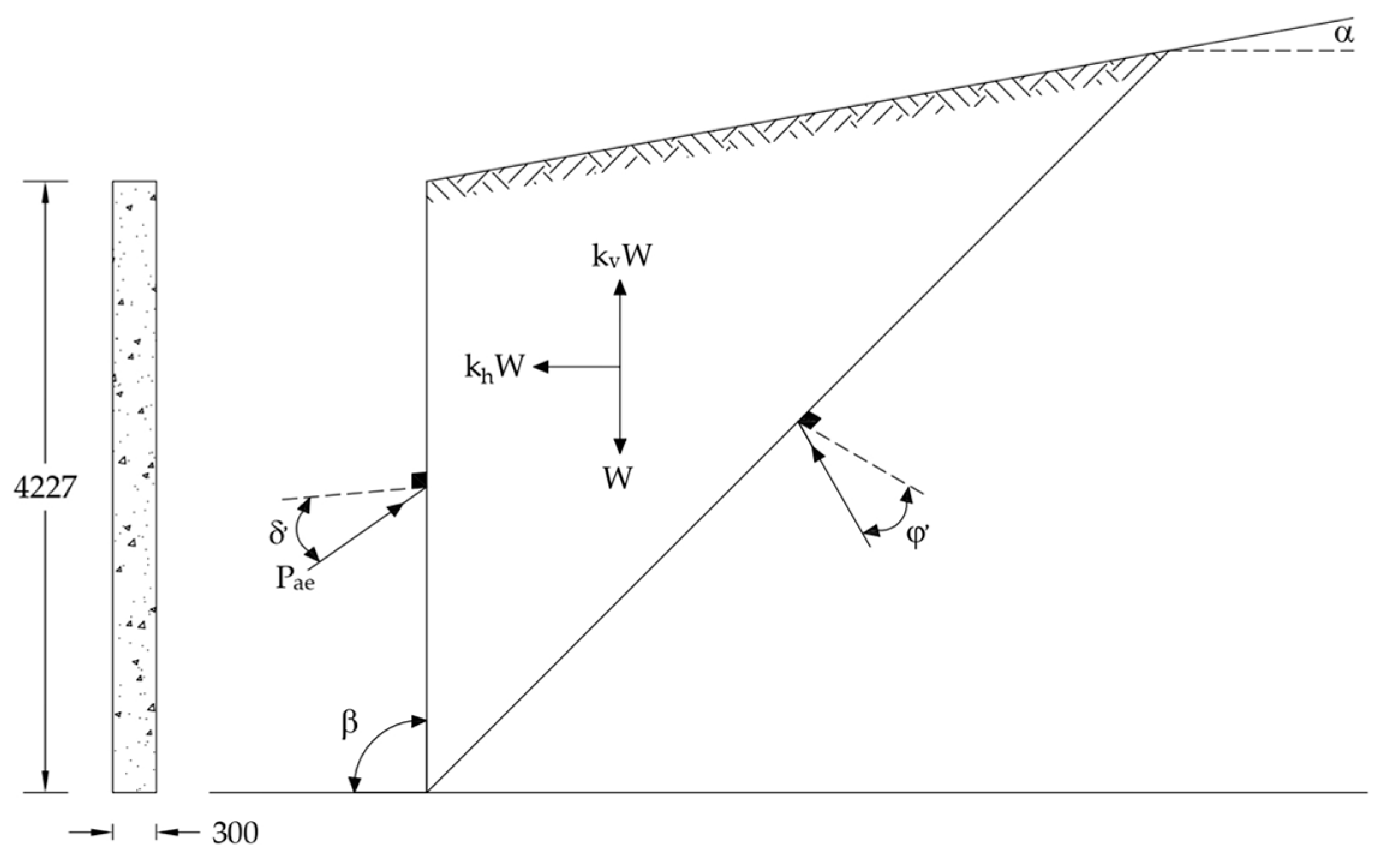
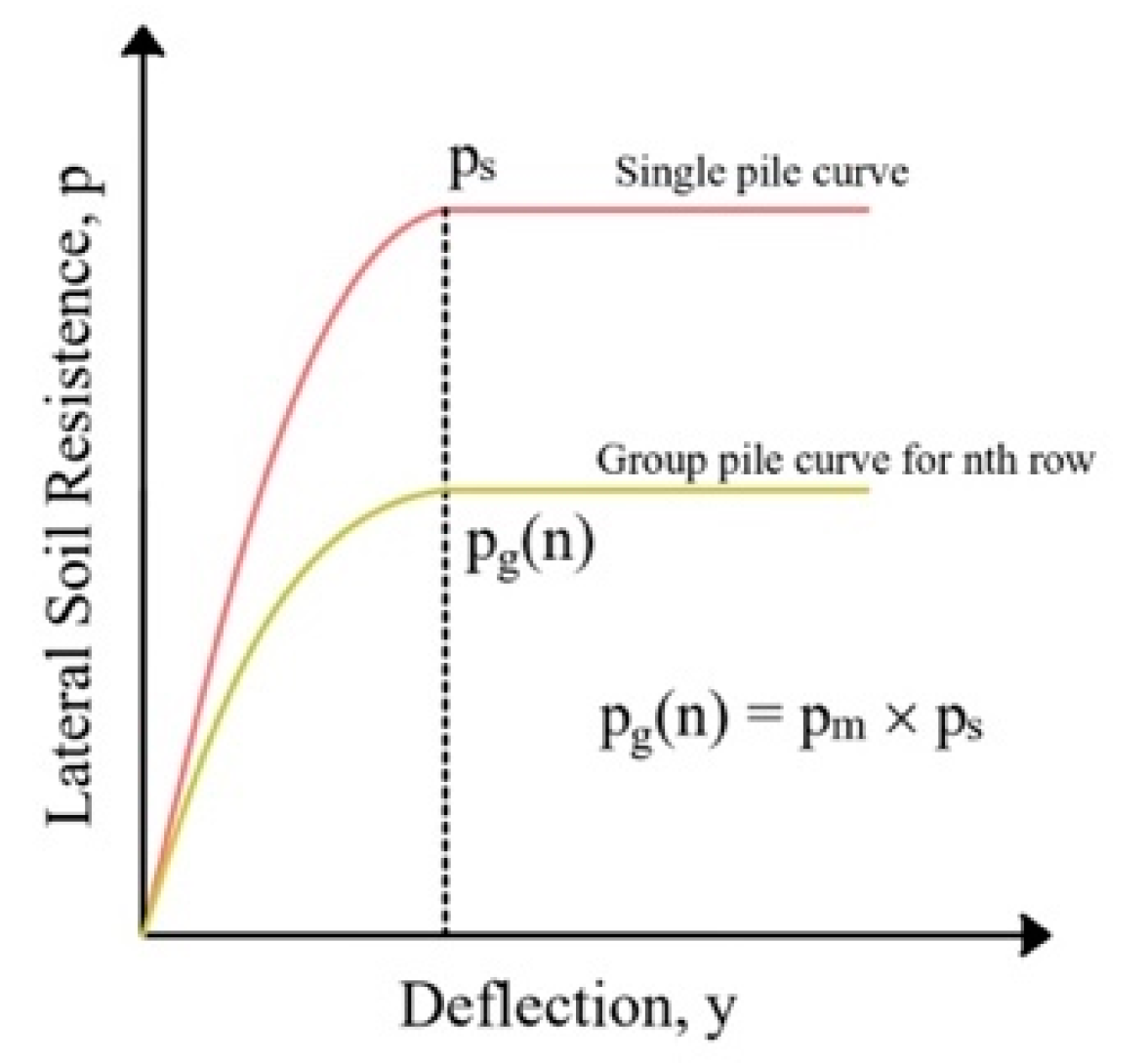
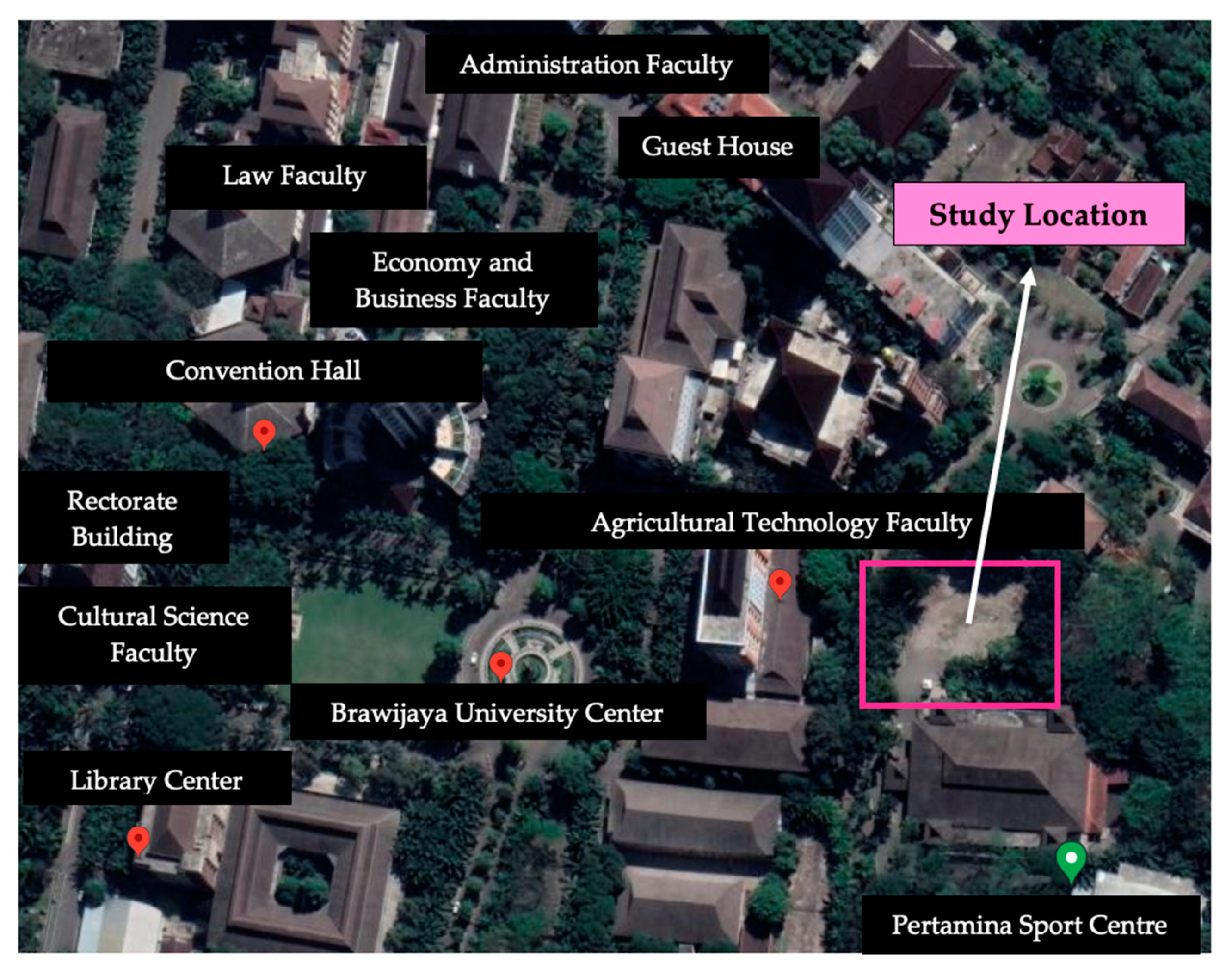
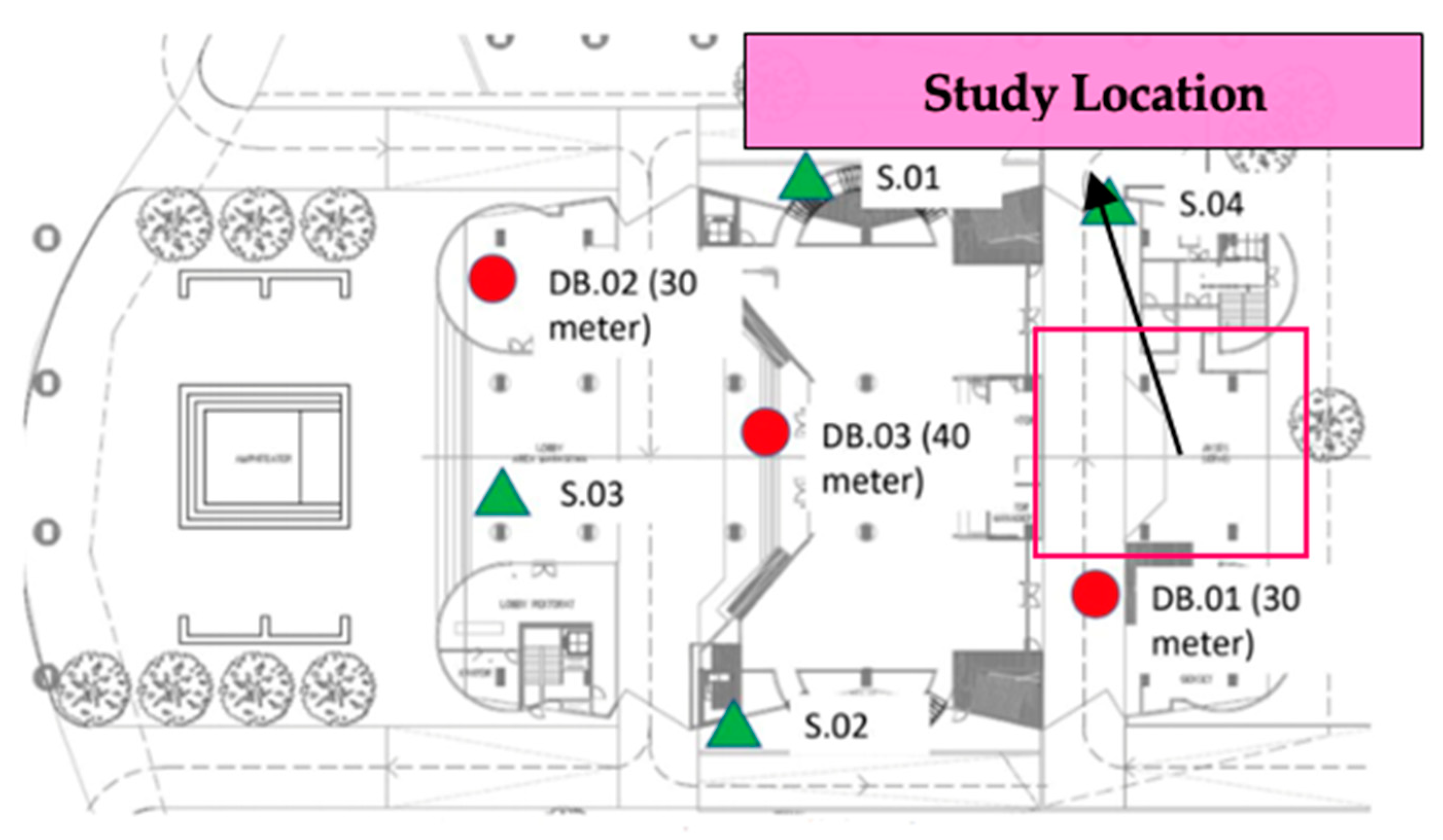

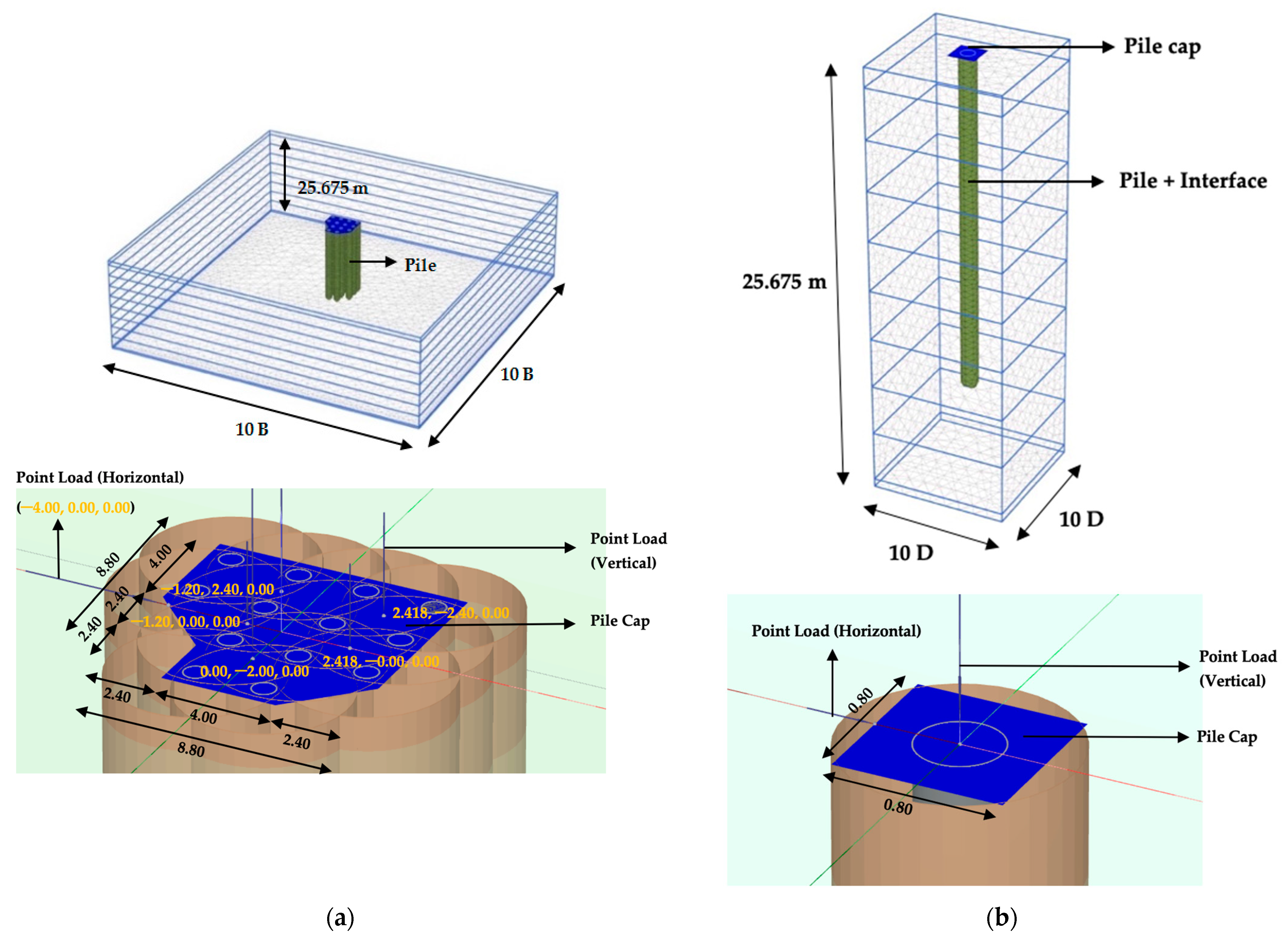


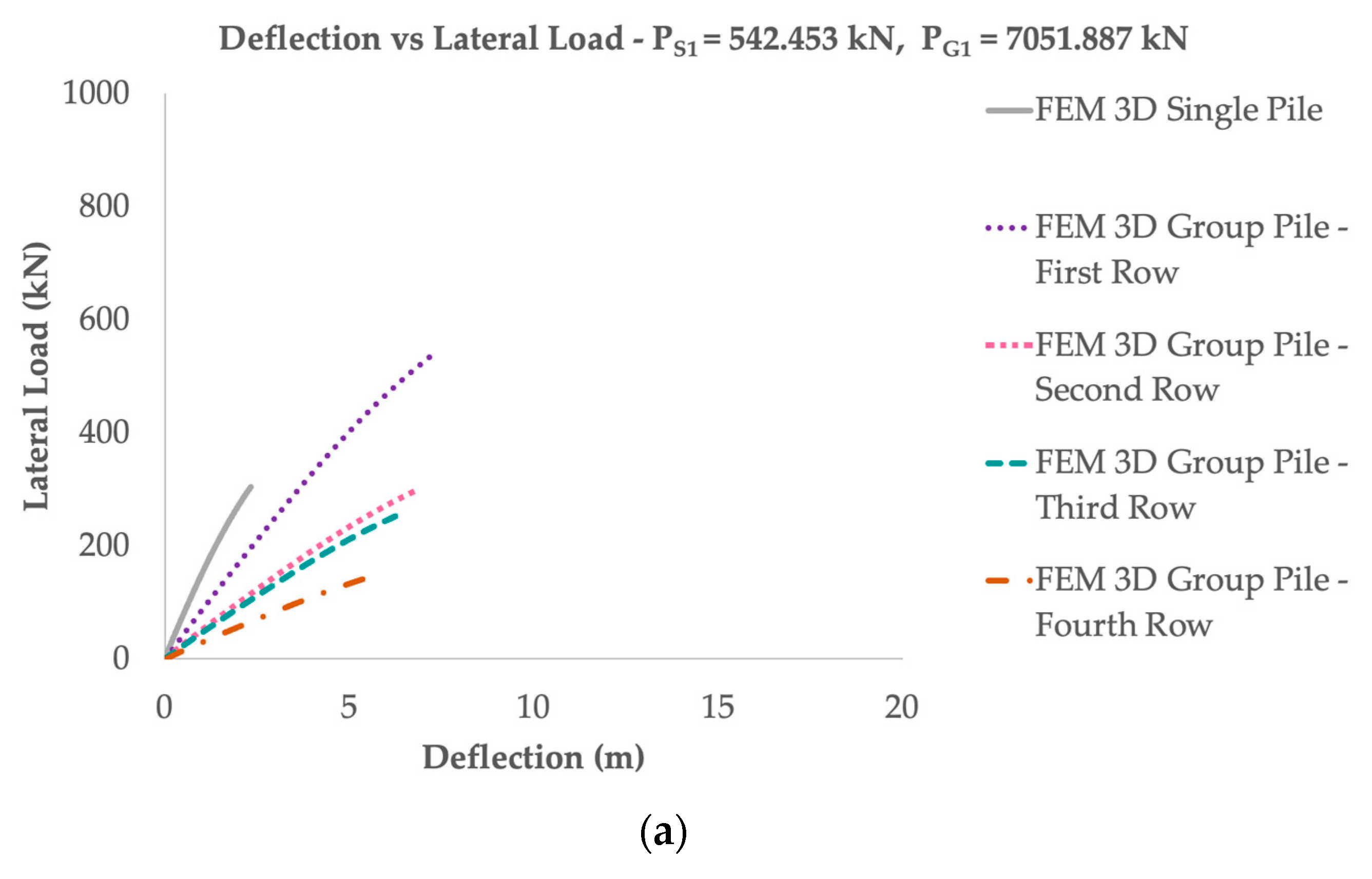
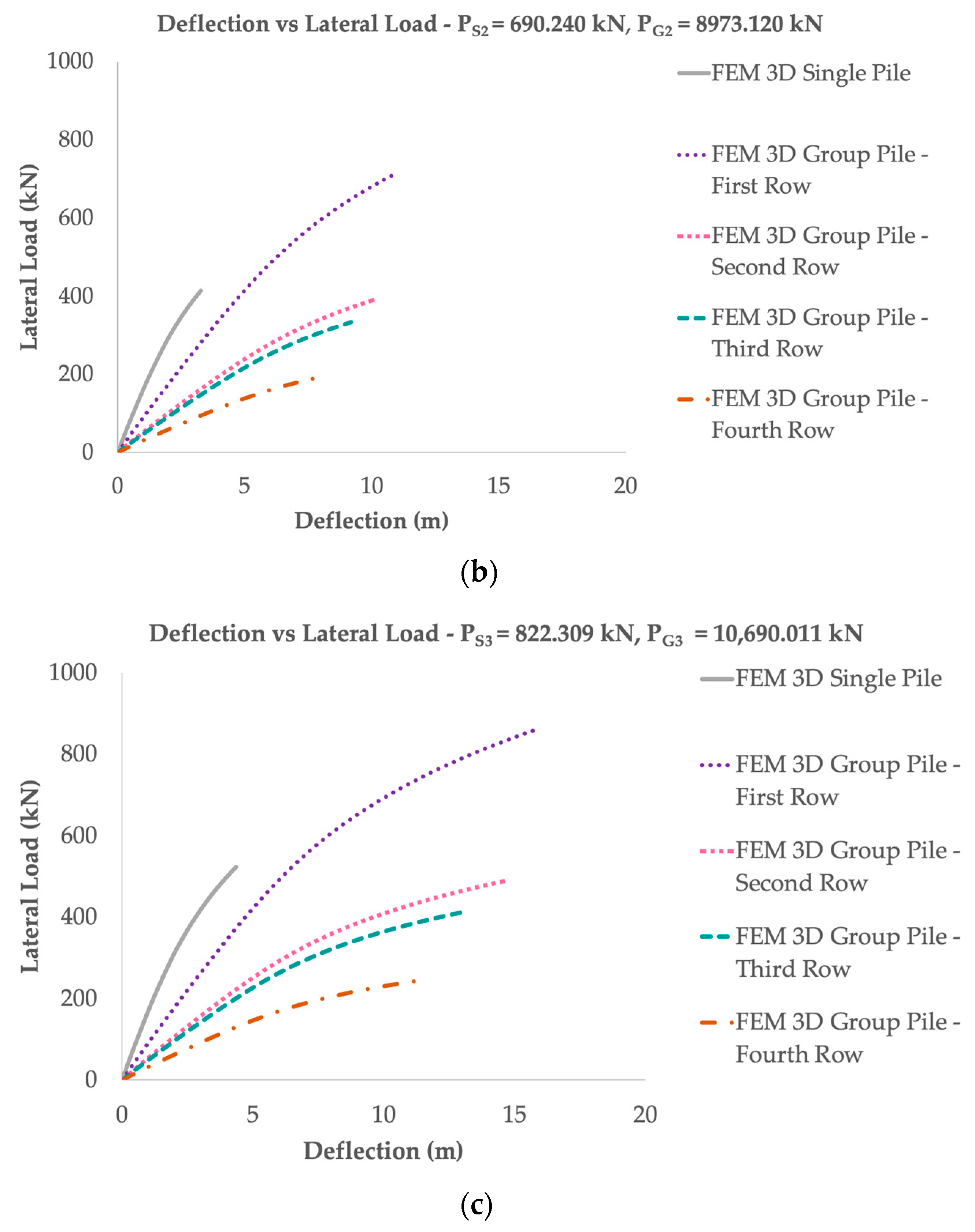
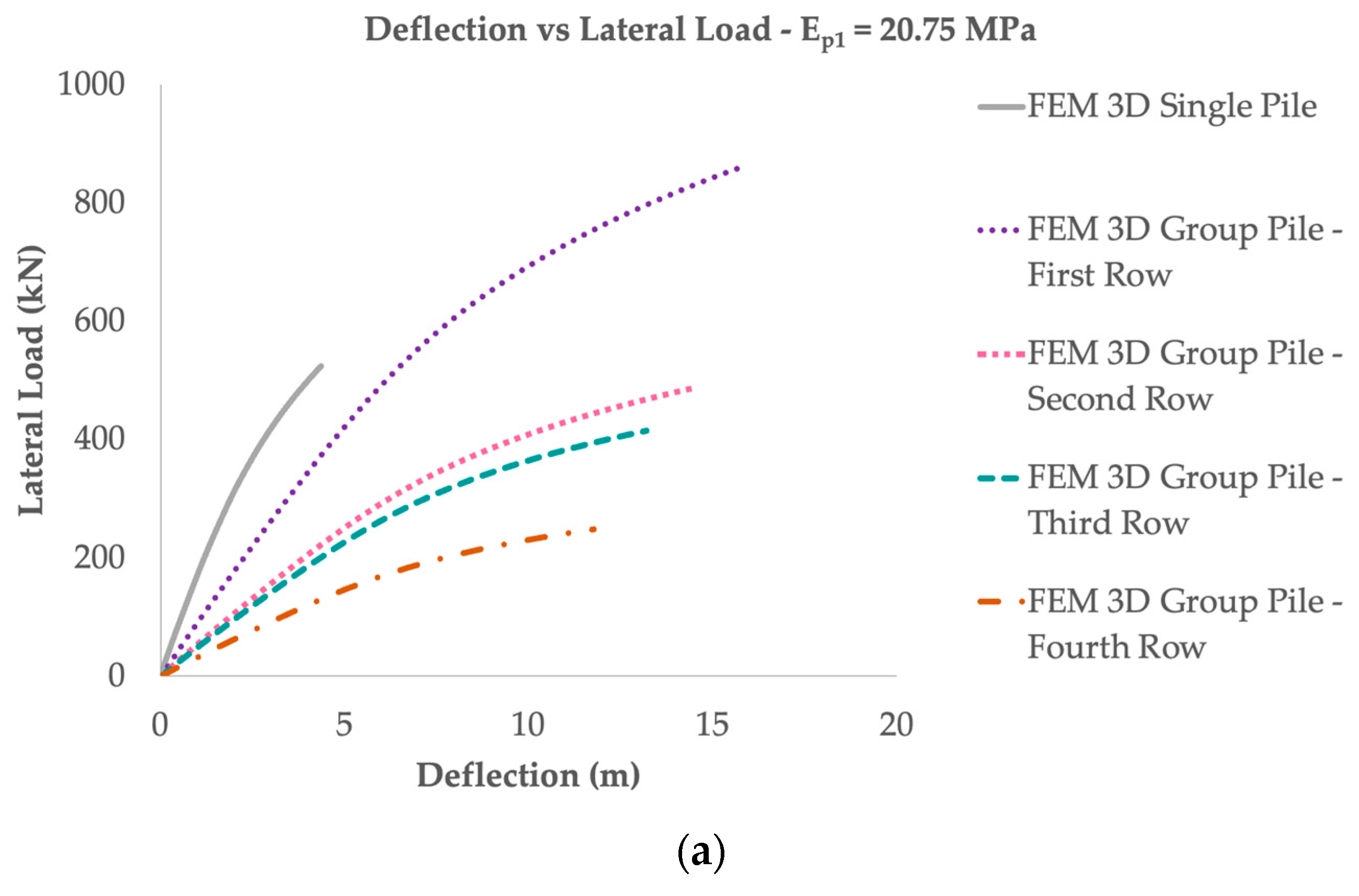
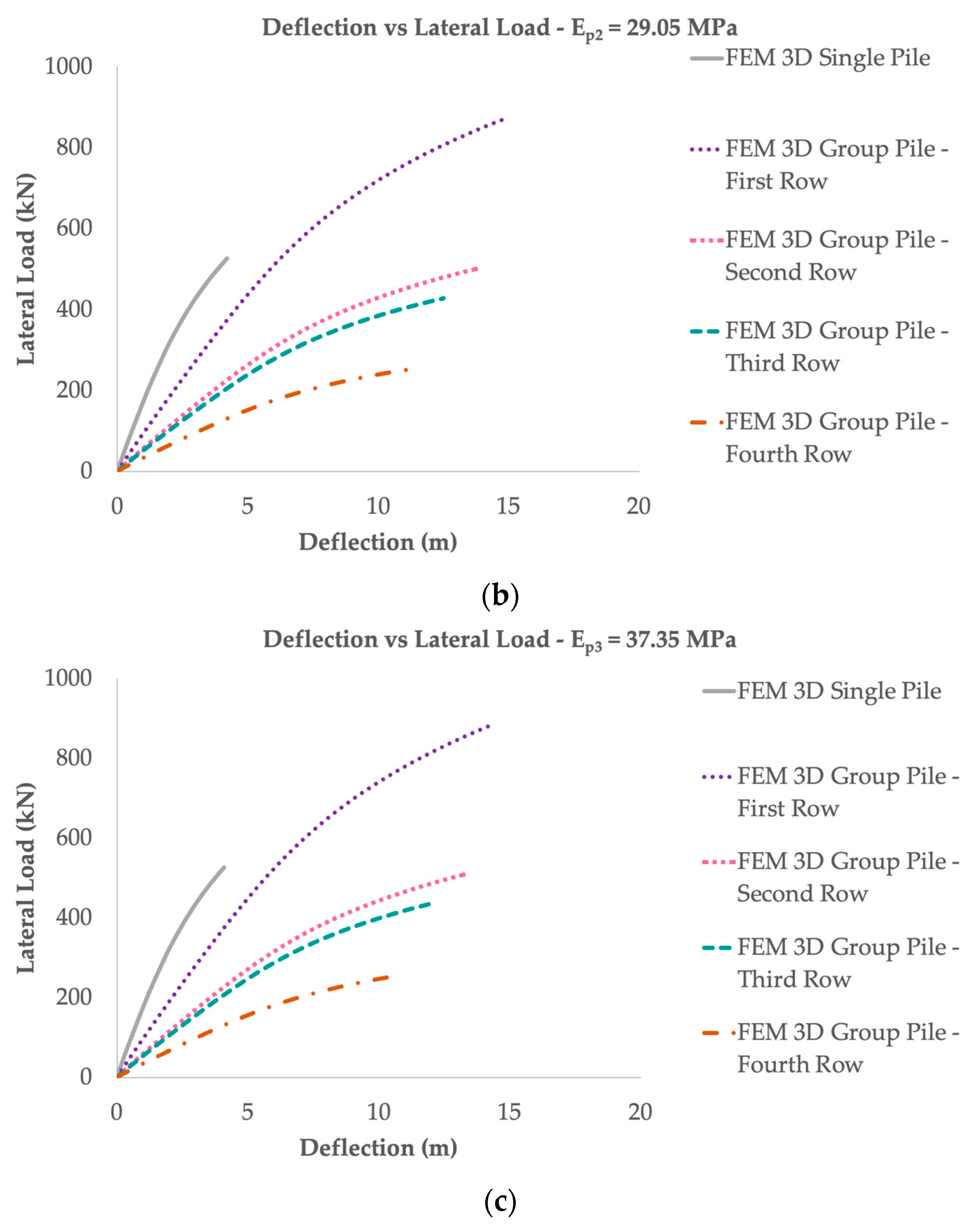

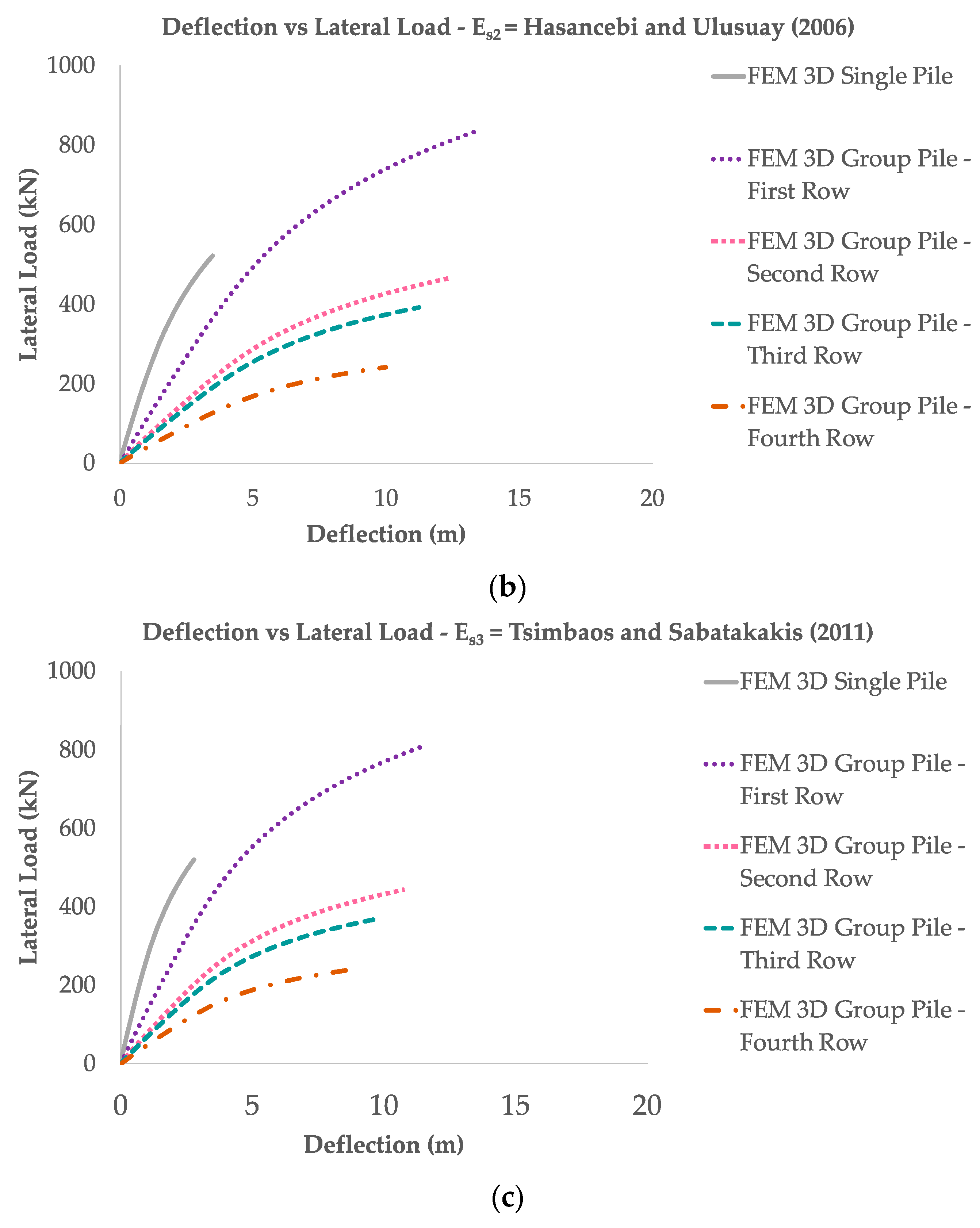


| Pile Space | p-Multiplier, pm | ||
|---|---|---|---|
| Row 1 | Row 2 | Row 3 and Upper | |
| 3D | 0.8 | 0.4 | 0.3 |
| 5D | 1 | 0.85 | 0.7 |
| Parameters | Methods | Unit | MH | MH | SC-SM | SC-SM | CL |
|---|---|---|---|---|---|---|---|
| Depth | M | 0.00–5.50 | 5.50–8.50 | 8.50–11.50 | 11.50–14.50 | 14.50–17.50 | |
| 60 | 12 | 11 | 14 | 28 | 34 | ||
| Vs | Maheswari et al., 2010 [23] | m/s | 176.67 | 172.18 | 194.68 | 233.75 | 243.14 |
| Hasancebi and Ulusuay, 2006 in Hammam and Eliwa [22] | 204.80 | 200.34 | 208.53 | 249.35 | 269.12 | ||
| Tsimbaos and Sabatakakis, 2011 [24] | 237.39 | 230.90 | 209.41 | 269.15 | 334.70 | ||
| Parameters | Methods | Unit | MH | SM | SM | MH | CL-ML |
| Depth | M | 17.50–20.00 | 20.00–23.50 | 23.50–26.50 | 26.50–29.50 | 29.50–30.00 | |
| 60 | 44 | 68 | 55 | 54 | 55 | ||
| Vs | Maheswari et al., 2010 [23] | m/s | 263.66 | 296.06 | 279.39 | 279.36 | 241.78 |
| Hasancebi and Ulusuay, 2006 in Hammam and Eliwa [22] | 288.43 | 314.14 | 296.83 | 303.06 | 305.09 | ||
| Tsimbaos and Sabatakakis, 2011 [24] | 365.18 | 372.23 | 343.76 | 388.62 | 456.36 |
| Parameters | Symbol | Unit | MH | MH | SC-SM | SC-SM | CL |
|---|---|---|---|---|---|---|---|
| Depth | M | 0.00–5.50 | 5.50–8.50 | 8.50–11.50 | 11.50–14.50 | 14.50–17.50 | |
| Shear Modulus | Gmax1 | kN/m2 | 31,512.89 | 30,168.81 | 54,463.84 | 58,647.40 | 62,843.00 |
| Gmax2 | kN/m2 | 42,346.40 | 40,843.44 | 62,487.42 | 66,734.39 | 76,989.80 | |
| Gmax3 | kN/m2 | 56,897.20 | 54,258.68 | 63,015.42 | 77,752.24 | 119,082.54 | |
| Modulus of Elasticity | Es1 | kN/m2 | 80,257.83 | 76,107.67 | 141,750.84 | 157,208.03 | 172,158.08 |
| Es2 | kN/m2 | 107,848.87 | 103,036.85 | 162,633.48 | 178,885.72 | 210,913.15 | |
| Es3 | kN/m2 | 144,907.24 | 136,879.86 | 164,007.69 | 208,419.75 | 326,226.01 | |
| Parameters | Symbol | Unit | MH | SM | SM | MH | CL-ML |
| Depth | M | 17.50–20.00 | 20.00–23.50 | 23.50–26.50 | 26.50–29.50 | 29.50–30.00 | |
| Shear Modulus | Gmax1 | kN/m2 | 71,347.32 | 137,818.78 | 132,539.58 | 81,007.64 | 66,740.49 |
| Gmax2 | kN/m2 | 85,382.60 | 155,159.96 | 149,607.27 | 95,333.66 | 106,266.07 | |
| Gmax3 | kN/m2 | 136,865.04 | 217,852.44 | 200,658.77 | 156,762.39 | 237,768.36 | |
| Modulus of Elasticity | Es1 | kN/m2 | 199,772.48 | 385,892.57 | 371,110.81 | 226,821.40 | 186,873.38 |
| Es2 | kN/m2 | 239,071.29 | 434,447.88 | 418,900.34 | 266,934.24 | 297,544.98 | |
| Es3 | kN/m2 | 383,222.10 | 609,986.82 | 561,844.55 | 438,934.70 | 665,751.40 |
| Parameters | Symbol | Unit | MH | MH | SC-SM | SC-SM | CL |
|---|---|---|---|---|---|---|---|
| Depth | 0.00–5.50 | 5.50–8.50 | 8.50–11.50 | 11.50–14.50 | 14.50–17.50 | ||
| Material model | Mohr–Coulomb | Mohr–Coulumb | Mohr–Coulumb | Mohr–Coulumb | Mohr–Coulumb | ||
| Behavior type | Undrained | Undrained | Drained | Drained | Undrained | ||
| Density above water table | γunsat | kN/m3 | 9.901 | 9.980 | 14.092 | 10.526 | 10.424 |
| Density below water table | γsat | kN/m3 | 15.532 | 15.417 | 18.159 | 16.092 | 15.918 |
| Effective density | γ′ | kN/m3 | 5.725 | 5.61 | 8.352 | 6.285 | 6.111 |
| Poisson ratio | v | 0.273 | 0.261 | 0.301 | 0.340 | 0.370 | |
| Cohesion | c | kN/m2 | 35.598 | 17.162 | 4.021 | 1.177 | 15.789 |
| Friction angle | φ | o | 30.45 | 25.62 | 44.26 | 44.29 | 31.75 |
| Rinter | 0.901 | 1.00 | 0.543 | 0.543 | 0.856 | ||
| Parameters | Symbol | Unit | MH | SM | SM | MH | CL-ML |
| Depth | M | 17.50–20.00 | 20.00–23.50 | 23.50–26.50 | 26.50–29.50 | 29.50–30.00 | |
| Material model | Mohr–Coulumb | Mohr–Coulumb | Mohr–Coulumb | Mohr–Coulumb | Mohr–Coulumb | ||
| Behavior type | Undrained | Drained | Drained | Undrained | Undrained | ||
| Density above water table | γunsat | kN/m3 | 10.065 | 15.419 | 16.652 | 10.179 | 11.196 |
| Density below water table | γsat | kN/m3 | 15.614 | 19.191 | 20.252 | 16.288 | 16.349 |
| Effective density | γ’ | kN/m3 | 5.807 | 9.384 | 10.445 | 6.482 | 6.543 |
| Poisson ratio | V | 0.4 | 0.4 | 0.4 | 0.4 | 0.4 | |
| Cohesion | C | kN/m2 | 19.221 | 9.12 | 0.588 | 21.673 | 3.825 |
| Friction angle | φ | o | 18.8 | 40.9 | 51.75 | 17.19 | 40.9 |
| Rinter | 1.00 | 0.611 | 0.417 | 1.00 | 0.611 |
| Lateral Resistance (kN) | The Difference of Lateral Resistance with the Single Pile (%) | ||||||||
|---|---|---|---|---|---|---|---|---|---|
| Single Pile | 1st Row | 2nd Row | 3rd Row | 4th Row | 1st Row | 2nd Row | 3rd Row | 4th Row | |
| Combination Lateral Loads Effect | |||||||||
| PS1, PG1 | 304.663 | 541.442 | 299.494 | 255.588 | 149.534 | 43.731 | 1.697 | 16.108 | 50.918 |
| PS2, PG2 | 414.567 | 711.253 | 389.264 | 333.519 | 197.712 | 41.713 | 6.103 | 19.550 | 52.309 |
| PS3, PG3 | 524.270 | 861.389 | 488.142 | 415.128 | 248.422 | 39.137 | 6.891 | 20.818 | 52.616 |
| Pile Stiffness Effect | |||||||||
| Ep1 | 524.270 | 861.389 | 488.142 | 415.128 | 248.422 | 39.137 | 6.891 | 20.818 | 52.616 |
| Ep2 | 525.274 | 875.012 | 500.002 | 427.055 | 252.604 | 39.970 | 4.811 | 18.699 | 51.910 |
| Ep3 | 526.043 | 885.202 | 509.006 | 436.031 | 255.516 | 40.574 | 3.239 | 17.111 | 51.427 |
| Soil Stiffness Effect | |||||||||
| Es1 | 524.270 | 861.389 | 488.142 | 415.128 | 248.422 | 39.137 | 6.891 | 20.818 | 52.616 |
| Es2 | 522.476 | 837.790 | 465.483 | 391.661 | 242.058 | 37.636 | 10.908 | 25.038 | 53.671 |
| Es3 | 520.390 | 812.899 | 443.048 | 367.568 | 237.664 | 35.983 | 14.862 | 29.367 | 54.333 |
| Deflection (mm) | The Difference of Deflection with Single Pile (%) | ||||||||
|---|---|---|---|---|---|---|---|---|---|
| Single Pile | 1st Row | 2nd Row | 3rd Row | 4th Row | 1st Row | 2nd Row | 3rd Row | 4th Row | |
| Earthquake Combination Load Effect | |||||||||
| PS1, PG1 | 2.417 | 7.466 | 7.361 | 7.199 | 6.555 | 67.622 | 67.165 | 66.426 | 63.127 |
| PS2, PG2 | 3.532 | 11.114 | 10.938 | 10.662 | 9.572 | 68.220 | 67.709 | 66.873 | 63.101 |
| PS3, PG3 | 4.972 | 16.257 | 15.977 | 15.539 | 13.824 | 69.416 | 68.880 | 68.003 | 64.034 |
| Pile Stiffness Effect | |||||||||
| Ep1 | 4.972 | 16.257 | 15.977 | 15.539 | 13.824 | 69.416 | 68.880 | 68.003 | 64.034 |
| Ep2 | 4.808 | 15.367 | 15.101 | 14.690 | 13.090 | 68.712 | 68.161 | 67.270 | 63.270 |
| Ep3 | 4.692 | 14.756 | 14.500 | 14.108 | 12.588 | 68.203 | 67.641 | 66.742 | 62.726 |
| Soil Stiffness Effect | |||||||||
| Es1 | 4.972 | 16.257 | 15.977 | 15.539 | 13.824 | 69.416 | 68.880 | 68.003 | 64.034 |
| Es2 | 3.939 | 13.852 | 13.616 | 13.241 | 11.768 | 71.564 | 71.071 | 70.251 | 66.528 |
| Es3 | 3.140 | 11.964 | 11.763 | 11.438 | 10.154 | 73.755 | 73.306 | 72.548 | 69.0.76 |
Publisher’s Note: MDPI stays neutral with regard to jurisdictional claims in published maps and institutional affiliations. |
© 2022 by the authors. Licensee MDPI, Basel, Switzerland. This article is an open access article distributed under the terms and conditions of the Creative Commons Attribution (CC BY) license (https://creativecommons.org/licenses/by/4.0/).
Share and Cite
Munawir, A.; Harimurti; Sumarsono, Q.A.R.P. Lateral Load Capacity and p-Multiplier of Group Piles with Asymmetrical Pile Cap under Seismic Load. Appl. Sci. 2022, 12, 8142. https://doi.org/10.3390/app12168142
Munawir A, Harimurti, Sumarsono QARP. Lateral Load Capacity and p-Multiplier of Group Piles with Asymmetrical Pile Cap under Seismic Load. Applied Sciences. 2022; 12(16):8142. https://doi.org/10.3390/app12168142
Chicago/Turabian StyleMunawir, As’ad, Harimurti, and Queen Arista Rosmania Putri Sumarsono. 2022. "Lateral Load Capacity and p-Multiplier of Group Piles with Asymmetrical Pile Cap under Seismic Load" Applied Sciences 12, no. 16: 8142. https://doi.org/10.3390/app12168142






